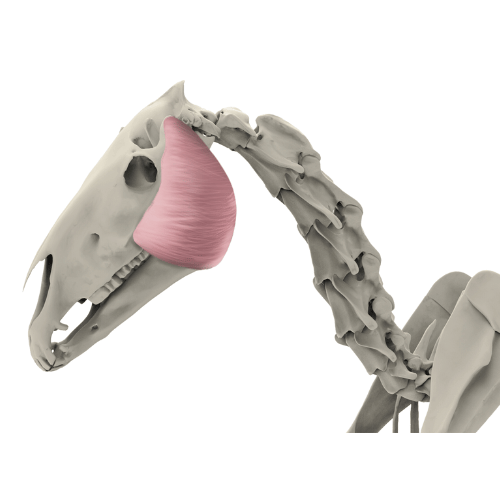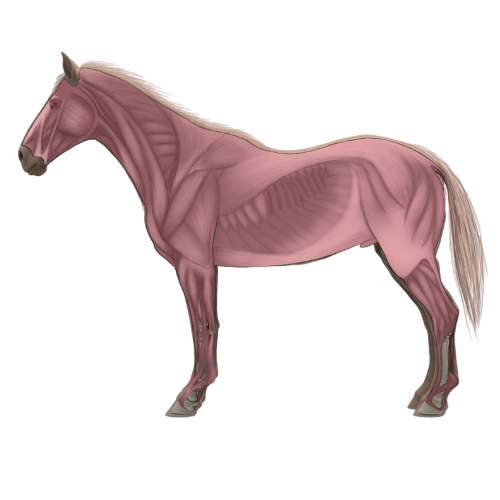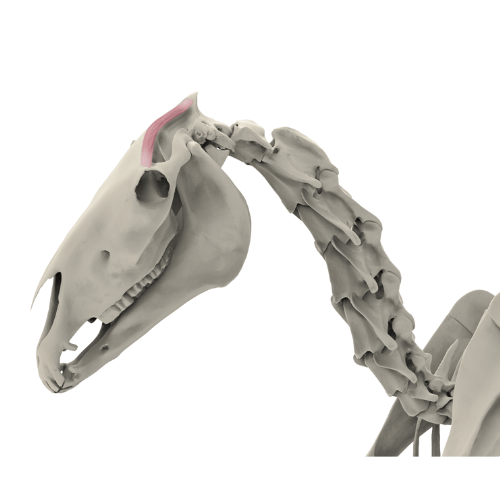The masseter muscle—also known as the external masseter muscle—is one of the strongest muscles in the horse's head and plays a pivotal role in chewing. This broad muscle extends from the zygomatic bone of the upper jaw across the lower jaw and can both close the mouth and move the lower jaw slightly sideways with every jaw movement.
/wp:paragraphwp:heading
Structure and function of the masseter muscle
/wp:headingwp:paragraph
The external masseter muscle has two main sections:
/wp:paragraphwp:list
- wp:list-item
- Pars superficialis , the superficial part, attaches to the facial crest of the maxilla. /wp:list-item
- Pars profunda , the deeper part, originates at the zygomatic arch and runs caudolaterally (i.e. backwards and to the side) to the lower jaw. /wp:list-item
wp:list-item
wp:paragraph
This structure and its strong musculature enable the masseter muscle to lift the lower jaw and press it sideways against the upper jaw. When both muscles contract simultaneously, the mouth closes tightly, which is crucial for chewing food.
/wp:paragraphwp:heading
Facts about the masseter muscle
/wp:headingwp:list
- wp:list-item
- Origin: Facial crest of the maxilla (superficial part) and zygomatic arch (profunda part) /wp:list-item
- Insertion: Caudolateral on the lower jaw /wp:list-item
- Function: Lifting and pulling the lower jaw sideways, pressing it against the upper jaw /wp:list-item
- Innervation: masticator nerve of the mandibular nerve /wp:list-item
wp:list-item
wp:list-item
wp:list-item
wp:heading
Chewing and stress: How tension manifests in the masseter muscle
/wp:headingwp:paragraph
Horses that are frequently under pressure or experience excessive tension in the reins often develop tension in the masseter muscle area. This tension can affect the horse's entire musculoskeletal system. A tense masseter leads to restricted chewing movement, which affects the chewing muscles and natural head carriage and can limit the horse's freedom of movement.
/wp:paragraphwp:heading
Symptoms of tension in the chewing muscles can be:
/wp:headingwp:list
- wp:list-item
- Difficulty chewing and eating, /wp:list-item
- Stiffness in the head and neck muscles, /wp:list-item
- a hard or cramped posture of the head, /wp:list-item
- Resistance or aggressiveness when working under the saddle. /wp:list-item
wp:list-item
wp:list-item
wp:list-item
wp:heading
How to relieve tension and fascial adhesions in your horse's chewing muscles
/wp:headingwp:paragraph
With the NeedleyRoll fascia and massage roller for horses, the entire masseter muscle can be worked evenly on both sides. Start with little to no pressure and work your way up gently. Pay close attention to your horse's reactions to find out what works for him. Stay mindful and try different pressure levels and movements to gently release tension and relax the muscle.
/wp:paragraphwp:heading
Conclusion: A relaxed masseter for a healthy horse
/wp:headingwp:paragraph
The masseter muscle plays an essential role in jaw function and thus in the horse's overall posture. Regularly checking the jaw and masseter for tension and ensuring relaxation contributes to your horse's health and performance.
/wp:paragraphwp:buttons
/wp:buttons
wp:woocommerce/all-products {"columns":3,"rows":3,"alignButtons":false,"contentVisibility":{"orderBy":true},"orderby":"date","layoutConfig":[["woocommerce/product-image",{"ima geSizing":"thumbnail"}],["woocommerce/product-title"],["woocommerce/product-price"],["woocommerce/product-rating"],["woocommerce/product-button"]]}
/wp:woocommerce/all-products




Leave a comment
This site is protected by hCaptcha and the hCaptcha Privacy Policy and Terms of Service apply.